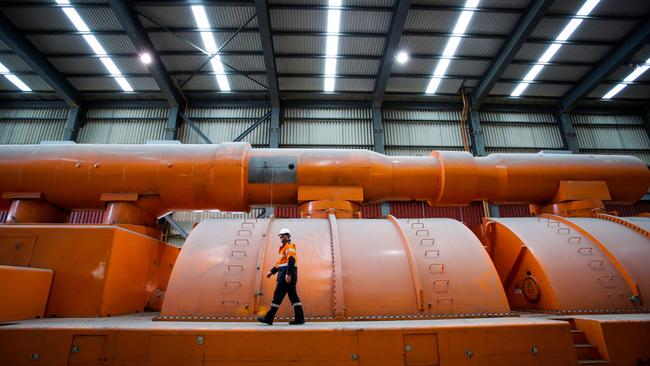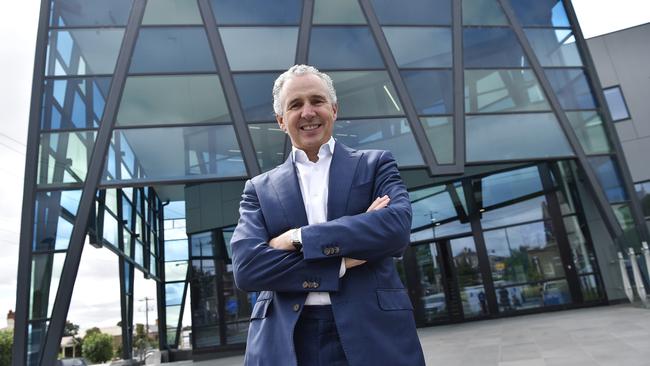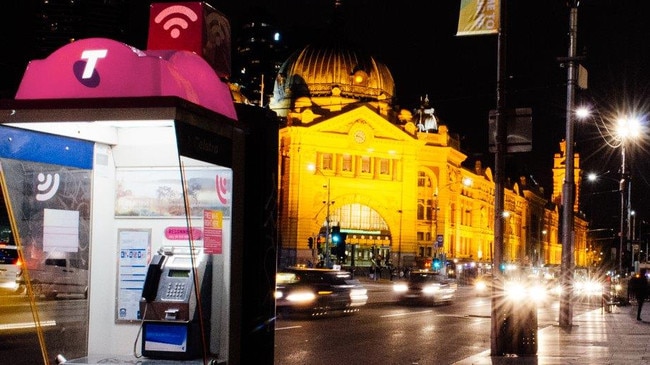
Spot prices surged to more than $520/MWh in NSW compared to Victoria’s daytime peak of $45 to keep Sydney’s air conditioners running. The Hunter Valley-based Eraring provides about a quarter of NSW’s electricity and its exit from the National Electricity Market will now be seven years earlier than had been planned.

That means a lot needs to go right in just three short years as opposed to 10, in a market where the states and federal government run their own race on energy policy.
Australia’s last coal fired power plant is scheduled to switch off by 2045 and while this will help underwrite a shrinking of the nation’s carbon footprint by 2050, consumers and business need to be prepared for the prospect of instability and price volatility across the grid particularly through hotter summers.
Calabria declared this an electricity market “in rapid transition” as he outlined plans to replace Eraring’s 2880 megawatt capacity with a 700MW monster battery.
“The cost of technology and the evolution with the influx of renewables and the supporting technologies is just playing out quickly,” Calabria says.
Origin, which is facing its own external investor pressure to reinvent itself and move away from coal, has previously doubted Eraring’s financial viability as ever more renewable energy including wind and solar is pumped into the market during the day.
In South Australia, where 60 per cent of power is from wind and solar, prices often turn negative during the day given the surge in peak power production. When it comes to wholesale electricity which delivers reliable, around the clock, the trend nationally is for prices to keep falling.

“That’s the trend that’s driven by the make-up of renewables coming in. And that’s what really sits at the heart of the challenge of running baseload coal plants,” Calabria says.
For Origin and AGL, which has flagged an early exit from its 2640MW Bayswater plant in the Hunter Valley, there’s also a first mover advantage in closing early. As more of the nation’s ageing coal-fired plants are retired it’s going to get little harder for those remaining in the system to close.
–
Why Telstra had to change
Behind the Covid-19 scenes, Telstra has been busy hacking into its costs, with nearly 2000 people leaving the telco in the past 12 months.
This comes on top of another 6000 jobs cut from the business since 2018 as part of a long-term program to secure $2.7bn in annual cost savings by 2022, which it is now on track to achieve. This shows how hard the telco has been running to keep ahead of a shrinking legacy business and reinvent itself.
The broader telco revenue pool has been barely growing and with large competitors such as Optus or TPG making deep inroads, Telstra is being forced to do things cheaper and smarter. It no longer has vast rivers of cash coming in from last century’s fixed line phone business, which has largely been transferred to the NBN.

In short, Telstra chief executive Andy Penn was facing his own burning platform six years ago as the NBN started to cut deep into his core fixed landline business. Initially Telstra thought revenues would be cut between $2bn-$3bn a year as its core customer base moved over to the NBN. But as the NBN rollout gained momentum it became clear to Telstra would see an annual revenue hit of up to $3.6bn. At the same time margins in Telstra’s great growth hope of mobiles were being compressed to wafer thin levels as technology costs came down.
“We almost had this perfect storm of economic pressure,” Penn says in an interview.
While cost levers were being pulled in the lead-up to 2016 and investments made in new sectors including health, Telstra was ultimately tackling the edges of a bigger problem. “We had to radically transform the core. And to do that, we have to radically simplify it and then we had to radically digitise business. And that’s what we’ve done,” he says.
Penn illustrates how necessary this change has been. Six years ago the telco offered around 1800 consumer and small business phone plans, which each came with their own administrative costs and complexity for customers. Today there are just 20.
The telco has also pushed deeper into new markets including health technology and renewable energy retailing, although both are relative minnows compared to the giant mobile business.
In the past six years it has taken out 27,000 jobs – nearly a third of its workforce – through a combination of job cuts and removing contractors.
Internal processes across the business including new sales are now built around doing more online. “We are now a vastly different company,” Penn says.
Covid has accelerated the adoption of digital ways of working or buying and selling online, and “that just validates that the position we took”.
Telstra on Thursday reported a headline profit drop of 34 per cent. Still, with rising cashflow and the sale of some of its mobile towers, the telco had confidence to deliver an interim dividend of nearly $1bn, including a special dividend of 2c on top of a steady 6c a share dividend. This comes on top of last year’s $1.35bn buyback.

Despite the Covid of recent years, Penn still expects to deliver the key targets, as his massive six-year T22 restructuring plan, with $2.7bn in annualised savings, comes to an end. Other areas include selling nearly half of the company’s new consumer and small business contracts online, simplifying the business and releasing $2bn in cash from the sale of fixed assets, including mobile phone towers.
There is a new goal of an additional $500m in savings within the next three years which shows the telco can’t afford to stand still.
The reason for this is that headline revenue for all of Telstra’s key businesses today is either flat or reversing. Even though all of us are using more and more data, competitive pressures are keeping a lid on growth. At the same time low population growth and a freeze on immigration have been acting as headwinds.
During the December half, Telstra, which dominates the super-fast 5G market, saw mobile revenue fall 0.6 per cent. Fixed line revenue fell 6.8 per cent and sales from business customers fell 2.1 per cent. A decade ago consumer fixed line revenue, including broadband, was running at $7.4bn; last year it was $4.7bn as more moved onto the NBN.

But Penn is pulling all the levers to get a better headline result. Earnings from his mobile business are up 25 per cent as average revenue per user increases and costs are lowered. So even if players such as Optus or TPG are discounting mobile phone plans, Telstra is generating more revenue per handset across its vast network, including 2.8 million 5G customers.
Consumers will feel the sting of inflation, with Penn revealing that the simplified mobile contracts and business plans have the option to pass through inflation costs, although he declined to comment on specific future pricing. However, he notes under the old system of 1800 different sales contracts, Telstra simply would not have be able to do this.
“If we make pricing increases in the future, inflation-driven or otherwise, we will have the benefit of that and it will flow through.”
johnstone@theaustralian.com.au








As Origin Energy boss Frank Calabria outlined plans to pull the plug on its Eraring coal-fired power station in just over three years, a late blast of summer heat saw NSW forced to suck in additional electricity from Queensland and Victoria.